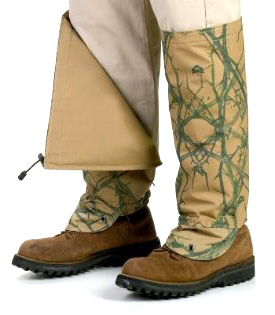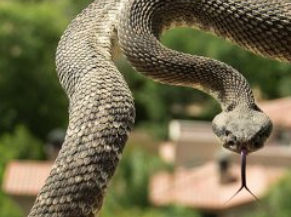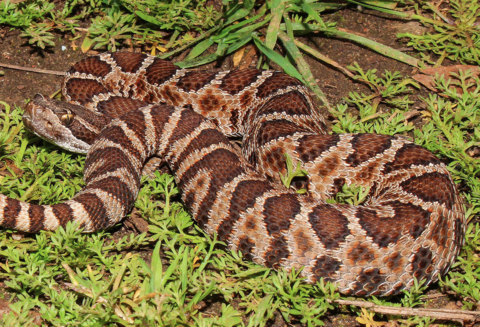Monday, November 27 2017
We appreciate receiving emails from our customers and try our best to answer questions and implement  suggestions. Lately, many emails have been from women asking about snake proof boots. Here are a few examples of their comments: suggestions. Lately, many emails have been from women asking about snake proof boots. Here are a few examples of their comments:
“I am interested in a pair of snake proof boss for hiking. The ones on this site look like they would be uncomfortable for hiking. Thoughts?”
“Got any suggestions for tall, slender girls? I’ve tried on lots of boots where the calves are huge on me. And I wear a women's size 11. Thanks!”
“So all you have are snake proof boots for men? All of these boots are BUTT UGLY!!! How about a nice looking, rugged snakeproof boot for women?”
Our honest recommendation to our female customers is not to buy snake boots at all— snake gaiters for  women, worn over pants and with your own hiking boots, are a far better option. Same goes for snake chaps if you need snake protection above the knee. Here’s why: women, worn over pants and with your own hiking boots, are a far better option. Same goes for snake chaps if you need snake protection above the knee. Here’s why:
Unfortunately, the major manufacturers of snake boots make them in men's sizes. Men are their target customers. And since there is no real sizing chart to convert men's to women's sizing, it is anyone’s guess what size a woman should buy. Snake gaiters or snake chaps, easily solve the problem because both are truly uni-sex is sizing. That being said, however, if you have access to a local store that stocks boots, you may have good luck by trying them on in person. But to avoid a lot of extra shipping costs associated with returns and exchanges, we do not suggest that women buy snake boots online. Male customers never seem to have this problem as their sizes are true and the fit is comfortable.
Another reason we suggest that women not bother with boots is because then you would be stuck wearing the same pair all the time, or would need to buy several pair with different tread or features. Depending on the weather and terrain, you may need a boot with aggressive tread for some hiking trails, but not so much for other outdoor activities in snake country such as when you are cleaning up your backyard landscaping. Snake gaiters or chaps allow women to wear their own comfortable, stylish hiking boots to match the terrain and circumstances. You can then switch boots as often as needed. Snake gaiters are available in several colors and go with any footwear!
Snake gaiters and snake chaps are a less expensive option than boots, too, and are available in a variety of sizes and colors and brands.. Just be sure to wear a thicker hiking boot with your gaiters or chaps. Snake fangs may penetrate tennis shoes or a light hiking shoe with mesh on top or sides, so avoid those styles. Also, when you choose gaiters or chaps, there is no guessing with the size. Measure the circumference of your calves while wearing the same pants you would normally wear out in the field, compare to the sizing charts on this website, and you can’t go wrong!
Sunday, August 20 2017
Rattlesnakes usually stay away from humans, but health officials say about 8,000 people are bitten by venomous snakes in the country every year. Snakes bites are most prevalent between April and October and are on a record pace this year, according to many poison control centers. It doesn’t seem to matter if you are on the East Coast or the West Coast, or down South— location doesn’t matter. Snakes are very temperature-dependent, so it’s more a matter of warm weather than a particular state or region. 
The number of calls last month to the Carolinas Poison Center about snake bites nearly quadrupled compared to last year. More than 500 calls about snake bites are expected in California. Georgia Poison Control reports a 50 percent increase in the number of bites reported this year compared to the same time period last year. This is a small sampling, but represents what most states are experiening in late summer.
A few species seem to cause the majority of poisonous bites: copperheads, cottonmouths (also called the water moccasin), eastern diamondback rattlesnakes, pigmy rattlesnakes, timber rattlesnakes, and sidewinders. It's true that there are ways to tell if a snake is venomous by its appearance, but most people aren't paying close enough attention to really know. It's better to assume ALL snakes are poisonous and avoid them. Don't be afraid to be outside, just be cautious and know what poisonous snakes look like that are common to the areas where you recreate and live. A rattlesnake, for example has a broad, triangular head. It has a relatively heavy or "fat" body, with a rattle on tail. The rattlesnake’s signature sound is a lot like bacon sizzling. However, these venomous creatures can lose their rattles over time, so don’t be lulled into a false sense of safety because you hear nothing. Even when not fatal, snake bites can be painful and scary. Bottom line: it's better to be safe than sorry, so follow these tips when in snake country no matter the state:
- Be alert. Like all reptiles, snakes are sensitive to the ambient temperature and will adjust their behavior accordingly. After a cold or cool night, they will attempt to raise their body temperature by basking in the sun midmorning. To prevent overheating during hot day, they will become more active at dawn, dusk or night.
- Wear sturdy boots or gaiters. Kid size snake chaps are worth considering, too. Never go barefoot or wear sandals when walking through brushy, wild areas. Startled snakes may not rattle before striking defensively. Children should not wear flip-flops while playing outdoors in snake country.
- When hiking, stick to well-used trails. Avoid tall grass, weeds and heavy underbrush where snakes may hide during the day. Never hike alone. Always have someone with you who can assist in an emergency.
- Do not step or put your hands where you cannot see. Step on logs and rocks, never over them, and be especially careful when climbing rocks or gathering firewood. Check out stumps or logs before sitting down, and shake out sleeping bags before use. Be careful when trimming tall weeds or working around wood piles even in your own backyard.
- Never grab “sticks” or “branches” while swimming in lakes and rivers. Rattlesnakes can swim! It’s not known why they take to the water, other than sometimes to escape predators.
- Teach children early to respect snakes and to leave them alone.
- Leash your dog when hiking in snake country so they can’t poke their noses into holes where a rattler might be hiding.
If you do get bitten, don’t try using an ice compress or a tourniquet. Don’t try “cutting and sucking.” Seek immediate medical attention and take comfort in the fact that the bites may cause intense, burning pain but are rarely fatal, unless it is a child or pet, in which case a bite can be deadly. Once at a hospital, treatment depends on the type of snake involved, the amount of venom injected and the health of the person bitten. If your dog is bitten, take it to the veterinarian immediately to receive the antivenin treatment.
Although snakes of any kind are not "out to get you," bites can and do occur. Your best defense is don't take a chance! Wear snake gaiters or snake pants when in known snake country - whether that be the desert or woods - and greatly reduce your chances of being bitten!
Sunday, June 04 2017
As the weather heats up, rattlesnakes especially become more active. They, like humans, tend to explore when the weather gets warm. Also like humans (those who enjoy the great outdoors, that is), rattlesnakes tend to avoid developed areas, preferring undisturbed, natural habitats. That means the more you hike, hunt, camp, fish, bike and recreate in wilderness areas, the greater your chances of encountering a pit viper. And another thing they have in common with humans is they tend to be found in log piles and rocks and other natural "seats" where you might be likely to enjoy your lunch or bask in the sun. They also can be found in swampy areas. Snakes are able to regulate their body temperature by moving in and out of shade. A warmer body allows a snake to move faster when trying to catch prey (insects, slugs, frogs, birds, bird eggs, small mammals, and other reptiles). 
Rattlesnakes are native to North America, living in diverse habitats. There are 36 known species of rattlesnakes, with between 65 and 70 subspecies. The state with the most types of rattlesnakes are Texas and Arizona. Even baby rattlesnakes possess dangerous venom as soon as they hatch. Rattlesnakes all have the ability to rattle, hence their name, but they don't always make a rattling sound, so someone can be standing next to one and not even know it.
It is impossible to know what each and every variety of poisonous rattler looks like, but in general, they all have a triangular head, much wider than the neck, thick body with dull skin, and bands of color or splotches of color on backs and tail. Become familiar with the most common snakes found where you live or recreate. The three most common are:
Northern Pacific Rattlesnake: The color pattern is usually dark-brown, dark-gray, olive-brown, or sometimes black or pale yellowish ground color overlaid dorsally with a series of large, dark blotches with uneven white edges. These blotches are also wider than the spaces that separate them. Additionally, a lateral series of blotches, usually darker than the dorsal blotches, is clearly visible on all but the darkest specimens. The first rings of the tail are about the same color as the last body blotches, but these rings become progressively darker; the last two rings, at the base of the tail, are usually black. The belly is pale yellow, usually with brown spots. A large, dark-brown blotch on the snout has a pale border behind it. There is a dark brown postocular stripe with a white border that extends from the eye to around the angle of the jaw.
Western Diamond-Backed Rattlesnake: A large and heavy-bodied species, this rattlesnake's coloring varies from chalky gray to dull red, appearing dusty due to minute flecks and dots on the scales. As suggested by its common name, this species has diamond-shaped markings over most of its body, which are edged with black and white. These markings are replaced by conspicuous black and white bands towards the rear of the tail, just in front of the rattle, while the head has two characteristic pale stripes, one in front of the eye and the other behind, which run diagonally down the head towards the mouth.
Timber Rattlesnake: This is the only rattlesnake species in most of the populous northeastern United States; it is the third largest venomous snake in the United States.The physical color of a timber rattlesnake can vary widely depending on its area. Some are gray with a rich black pattern, some are tan with a sulfur yellow pattern, and some are a combination of both. They have V or W-shaped crossbar markings, which create a distinct pattern across its back. Generally they have a wide head and narrow necks. They have a distinctive rattler on its tail made up of a special scales. Their eyes are yellow, with elliptical pupils. These are large snakes, generally ranging from 36-60 inches (90-152 cm) in length and between 1.5 to 3 pounds.
It is estimated that 7,000 to 8,000 people are bitten by venomous snakes in the United States each year, resulting in many deaths. The most important factor in survival is the time elapsed between the bite and treatment. Most deaths occur between six and 48 hours after the bite. If antivenom treatment is given within two hours of the bite, the probability of recovery is greater than 99 percent. Still, any bite by a rattlesnake must be considered a life-threatening medical emergency!
When a bite occurs, the amount of venom injected is under voluntary control by the snake. The amount released depends on a variety of factors, including the condition of the snake (e.g. having long, healthy fangs and a full venom sack) and its temperament (an angry, hungry snake that has just been stepped on vs. a satiated snake that was merely surprised by walking near it). About 20% of bites result in no envenomation at all. Common symptoms include swelling, severe pain, tingling, weakness, anxiety, nausea and vomiting, hemorrhaging, perspiration, and eventually heart failure. Local pain is often intense, and will increase. Children generally experience more severe symptoms because they receive a larger amount of venom per unit of body mass.
What to do if bitten by a snake:
If bitten by a rattlesnake, stay calm and send someone to call 911. Always hike with a friend so you can help each other in case of emergency. The victim should remain calm by lying down with the affected limb lower than the heart. Do not waste precious time on tourniquets, "cutting and sucking," or snake bite kits. If you are by yourself, walk calmly to the nearest source of help: another person or a phone to Dial 911. Do Not Run. If you are not sure what kind of snake bit you, check the bite for two puncture marks (in rare cases one puncture mark) associated with intense, burning pain. This is typical of a rattle snake bite.
Although snakes of any kind are not "out to get you," bites can and do occur. Your best defense is don't take a chance! Wear snake gaiters or snake boots when in known snake country - whether that be the desert or woods - and greatly reduce your chances of being bitten!
Tuesday, May 02 2017
“Rattlesnake encounter in California State Park sends hiker to hospital”
“Elderly woman hospitalized after snake bite in Mobile”
“Rattlesnakes are coming out in Phoenix”
“Man flown to hospital after being bit by rattlesnake in Dallas”
“SC woman dies after rattlesnake bite at nature preserve”
“Rattlesnake bites boy who mistook it for a toy.”
 Headlines like these, while scary, serve a good purpose— to remind us to be alert and prepared while we’re in snake country. Worldwide, there are over 100,000 confirmed deaths from snakebites every year; the vast majority of those deaths do not occur in the United States. But when people here do get bitten, whether it’s by a rattler, cottonmouth, copperhead, coral snake, or other viper, it’s usually between the months of April and October. Headlines like these, while scary, serve a good purpose— to remind us to be alert and prepared while we’re in snake country. Worldwide, there are over 100,000 confirmed deaths from snakebites every year; the vast majority of those deaths do not occur in the United States. But when people here do get bitten, whether it’s by a rattler, cottonmouth, copperhead, coral snake, or other viper, it’s usually between the months of April and October.
Just about a quarter of all rattlesnake bites are “dry,” where no venom is injected. Other bites that do inject poisonous venom will definitely ruin your day, but not always kill you. The effects of being bitten are unpleasant to say the least. According to bite victims, your face starts tingling, your flesh feels like someone has sewn hot coals beneath your skin, your pulse flutters, and your limb puffs up like a water balloon. Not to mention the cost of being treated with anti-venom. Why even take that chance?
Overall, rattlesnakes are an important part of the ecosystem as they eat rodents and are eaten by other predators. They are generally shy creatures and will gladly retreat if given enough room, but their bites can be extremely dangerous, so knowing what to do to avoid them in the first place is key. The sound of rattling can instill cold fear in a hiker, but that's a good thing. You got the warning before accidentally stepping on or too close to a snake!
Despite the headlines, it’s possible to live and recreate safely around rattlers by taking precautions. The U.S. Fish and Wildlife Service recommends:
- Never go barefoot or wear sandals when walking through wild areas. Wear over-the-ankle hiking boots with snake gaiters, or wear snake proof boots. For full leg protection, consider snake chaps.
- When hiking, stick to well-used trails. Avoid tall grass, weeds and heavy underbrush where snakes may hide during the day.
- Do not step or put your hands where you cannot see and avoid wandering around in the dark. Step on logs and rocks, never over them, and be especially careful when climbing on rocks or gathering firewood.
- Check out stumps or logs before sitting down, and shake out sleeping bags before use.
- Never hike alone. Always have someone with you who can assist in an emergency.
- Teach children to respect snakes and to leave them alone. Children are naturally curious and will pick up snakes.
- Seek IMMEDIATE professional medical attention if bitten.
Monday, February 20 2017
Most posts on this blog are about protecting yourself from snake bite while outdoors— while hunting, hiking, clearing brush, or just walking your dog while in the desert or woods where snakes live. But what if you found a rattlesnake in your bathroom at home?!
Unfortunat ely, a family in Texas was recently taken by surprise when they discovered a live rattlesnake slithering in their toilet bowl! According to the family, the snake was pretty much alive and was doing its best to climb out of the toilet bowl. The family called in a snake removal company. Lucky they did that, not only for their own immediate safety, but because upon inspecting their house, the snake removal company found more than one stray snake. Unbeknownst to anyone, their cellar had become a rattlesnake den! ely, a family in Texas was recently taken by surprise when they discovered a live rattlesnake slithering in their toilet bowl! According to the family, the snake was pretty much alive and was doing its best to climb out of the toilet bowl. The family called in a snake removal company. Lucky they did that, not only for their own immediate safety, but because upon inspecting their house, the snake removal company found more than one stray snake. Unbeknownst to anyone, their cellar had become a rattlesnake den!
According to the company’s spokesperson, the snake removal team found more than 20 rattlesnakes in the family’s storm cellar. And, five of those snakes were infants. Rattlesnakes are extremely protective of their infants, but fortunately no injuries were reported by the family, and the large rattlesnake population was successfully relocated. As for the little creeper that exited through the family’s toilet, the experts believe that the snake somehow managed to enter a relief pipe and to make its way up. To ensure the family’s safety, the snake removal company sealed the relief pipe. After a clean sweep, no other rattlesnakes were found on the Texas family’s property.
Although the family claimed that they hadn’t seen a rattlesnake on their property for years, the company’s spokesperson declared that even though we can’t see them, snakes are still out there. Rattlesnakes and other poisonous vipers can be masters of disguise— relying on skin camouflage in order to elude bigger predators. That's how snakes can take up residence in your residence— if you don't hear a rattle, you don't necessarily know that they are there. Or they might be living in an area of your home or yard where you don't visit very often, such as a basement or outbuilding.
In addition to checking the rarely used areas of your home and property, your best defense against unwanted visitors is to make your property unattractive to snakes. Don't give them places to hide (abandoned junk piles and overgrown brush) and eliminate their food source such as mice and other small rodents. The neurotoxin carried by the snake’s venom can kill an adult in six hours or less. Even if not fatal, rattlesnake bite symptoms may include pain, tingling, swelling, numbness, nausea, weakness, and breathing issues— so don't take a chance! Whenever you are in snake country, protect yourself by wearing snake gaiters or snake boots and keep your eyes open to stay safe!
|